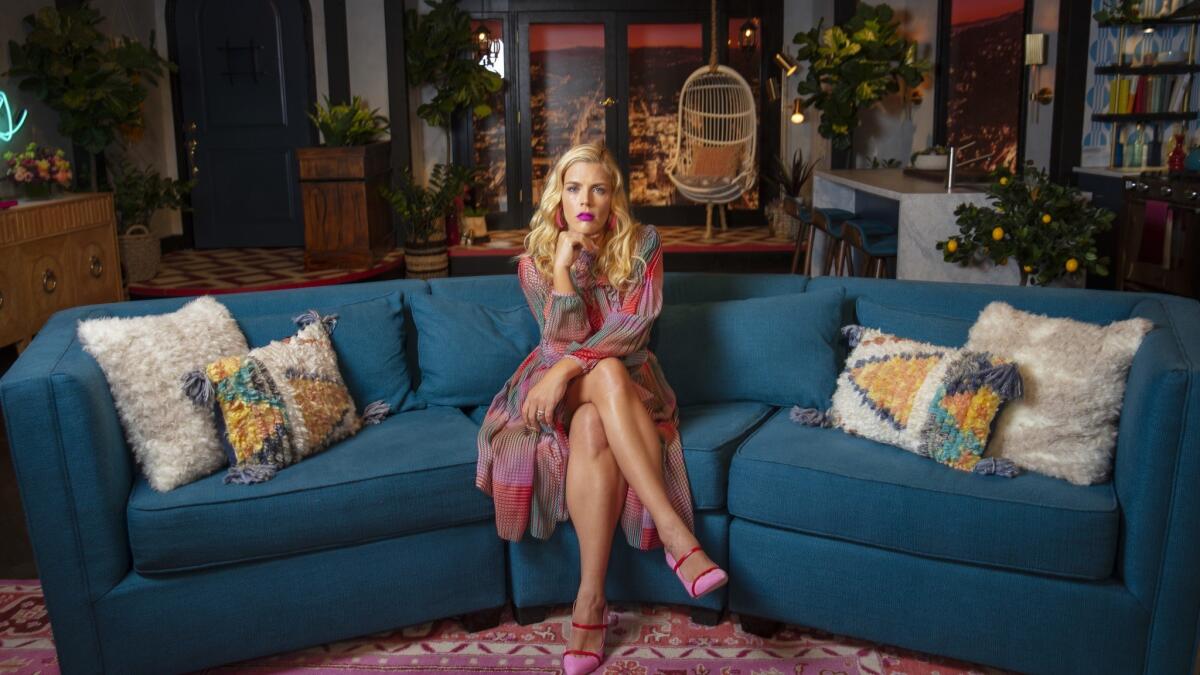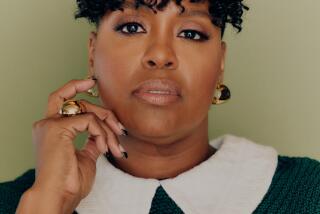‘Late Night’ makes late night look bleak for women. So we asked how bad it really is
- Share via
In the movie “Late Night,” which opened in limited release Friday, Mindy Kaling plays Molly Patel, a woman plucked from obscurity to help revitalize a long-running but creatively stagnant late-night show.
As the only woman or person of color on the writing staff, she is not exactly welcomed with open arms: On her first day on the job, she resorts to sitting on an overturned trash can because there are no available chairs, and her male colleagues keep barging in on her in the ladies’ room, which in the past was always empty.
For many women in late-night television, this depiction of a male-dominated workplace rings true, with one glaring exception: The show Molly works for is hosted by, of all things, a woman. Played by Emma Thompson, Katherine Newbury has been around late night so long she’s had the chance to grow out of touch — a character with about as much basis in reality as a fire-breathing dragon.
Written by Kaling, who was for a time the sole woman and person of color on the writing staff at “The Office,” “Late Night” arrives at a moment of contradiction. While there are now more women writing for late-night shows than ever before, female hosts, like female presidents, largely remain a figment of the Hollywood imagination. A wave of recent cancellations of female-fronted shows leaves “Full Frontal With Samantha Bee” as the only show currently on the air hosted by a woman. (At least until “A Little Late With Lilly Singh” debuts on NBC in September.)
Bee may have less competition, but she doesn’t see that as a good thing. “It doesn’t excite me being the only woman late-night host anywhere,” she said in an interview.
More encouraging are the gains made by female comedy writers. A decade ago, a tally of women writing for late-night shows read like binary code: zeros and ones across the board.
The days of such egregious exclusion appear to be over — every show currently on a broadcast, cable or streaming network has at least two credited writers who are women — but there is progress yet to be made: not a single show has a writers room that is 50% (or more) female.
Progress has not been easy, according to women in late-night TV. One of the less plausible aspects in “Late Night” is the ease with which Kaling’s character, who works at a Pennsylvania chemical plant, scores a job as a writer, despite having zero connections or experience in the industry. It’s the kind of flourish the phrase “only in the movies” was invented for.
For aspiring comedy writers, the process can be as brutally competitive as getting into the Ivy League — and just as reliant on powerful connections.
“I feel like most of Hollywood is governed by whose lacrosse team you were rivals with,” says Bee, who was for several years the lone female correspondent at “The Daily Show.”
Applicants submit packets — writing samples in the style and tone of a particular show. It’s not unusual to submit dozens of packets before getting hired (if ever).
RELATED: Mindy Kaling mines her TV past for big-screen breakout ‘Late Night’ »
Jenny Hagel, a writer for “Late Night With Seth Meyers,” says she submitted about 35 packets over seven years before she was hired on the NBC program, which has the highest proportion of female writers of any show on broadcast late night.
“I don’t think anybody has malintent, but at every stage it’s a little harder for women and people of color” to break through, says Hagel. She developed and stars in one of the show’s signature bits, “Jokes Seth Can’t Tell,” in which she delivers punchlines about lesbians and the Hispanic community that are off-limits to her straight, white, male boss.
“Even being able to find out about jobs is so difficult and relies so much on systems that inherently have gender bias built into them, because the whole field is so male-dominated,” says Hagel, who couldn’t find an agent to represent her until after she was hired at “Late Night.”
Molly McNearney, co-head writer of “Jimmy Kimmel Live!,” has seen this disparity play out from the other side of the hiring process.
“The sad fact is that more men are applying for these jobs than women,” she says. “It’s very frustrating. We’ll get a group of 300 packets and maybe 50 will be from women.”
To level the playing field, she’s made it her responsibility to look beyond the traditional gatekeepers, often sending direct messages to talented women on Twitter. (“I probably creep out a lot of people,” she says.)
McNearney started as an assistant at “Jimmy Kimmel Live!” 16 years ago, but quickly worked her way into the writers room, where for a time she was the only woman. As one of the show’s guiding creative forces, she’s voiced her objection to jokes about Hillary Clinton’s pantsuits, vented about Brett Kavanaugh, and is currently planning a segment about abortion with the show’s other female writers.
“Having women in the room and people from different backgrounds is essential, because Jimmy only has one voice,” she says.
Review: Mindy Kaling and Emma Thompson make ‘Late Night’ a great night »
Nell Scovell, who was the second woman to write for “Late Night With David Letterman,” after trailblazing head writer Merrill Markoe, says the industry has “a broken doorbell problem. There are plenty of women with the talent and the ability and nobody’s opening the door for them.”
And they’re definitely not leaving the door open for female hosts. While Peak TV has opened up more opportunities for women and people of color to host late-night shows, the crowded marketplace has also made it hard for newcomers to break through the noise.
In the past two years, a spate of shows hosted by women have been canceled after one- or two-season runs, including “Chelsea,” “The Break with Michelle Wolf,” “The Rundown with Robin Thede,” “I Love You, America with Sarah Silverman” and “Busy Tonight.”
Late-night shows require time to find a voice — and, these days, an audience. Virtually every long-running (male) host got off to a bumpy start, from a then-unknown Conan O’Brien, who took over “Late Night” in 1993, to Stephen Colbert, who made the awkward leap to “The Late Show” in 2015.
But like female directors who get sent to movie jail after a single flop, women in late night rarely get the chance to grow. In the mid-’80s, Joan Rivers was Johnny Carson’s permanent guest host on “Tonight,” filling in for him eight weeks a year.
For Scovell, who watched Rivers on “Tonight” during her post-college years in New York, “it changed the idea of what was possible for me. You’ve got to see it to be it.”
When Rivers left for her own Fox talk show in 1986 — a move she said she made because her future at NBC was not secure — she was widely condemned as disloyal to Carson. Some affiliates refused to carry her show, and Rivers was fired after less than a year on the air at the fledgling network.
“It was pure sexism — her ambitions [were] seen as unholy,” says Scovell, who recounts her experiences as the token woman at “Late Night” in her memoir, “Just the Funny Parts.”
Chelsea Handler’s talk show, “Chelsea Lately,” lasted a relatively impressive seven seasons on E!. A later deal with Netflix resulted in “Chelsea,” a talk show canceled after two seasons as the streamer continues to struggle in the chat show space.

[The industry has] a broken doorbell problem. There are plenty of women with the talent and the ability and nobody’s opening the door for them.
— Nell Scovell, the second woman to write for “Late Night With David Letterman”
More recently, “Busy Tonight,” hosted by the actress Busy Philipps, boasted an all-female writing staff, led by showrunner Caissie St. Onge. Unlike other late-night newcomers, “Busy Tonight” was playful and unabashedly feminine, with talk of face masks as well as more serious political issues.
The goal was “Mr. Rogers for grown-ups with cocktails meets ‘Pee Wee’s Playhouse,’ ” says St. Onge, who got her start as David Letterman’s assistant (she wrote funny thank you notes for him) and later worked for Rosie O’Donnell’s daytime talk show. “The world is really hard right now. We wanted to give people something fun and soothing to look forward to — a small treat.”
The show was canceled last month by E!, less than seven months after its debut. (Ironically, days later Philipps spoke on the air about having an abortion when she was 15, and the segment went viral.)
“I went into it with the best hopes,” St. Onge added. “But you’re working in a system where women aren’t given late-night shows on big networks. So women have to take their shows to smaller outlets with fewer resources and less luxury of time.”
With YouTube phenomenon Lilly Singh set to make history on NBC — not only as the first woman with a daily show on broadcast television in more than 30 years, but also as a bisexual person of color — this may change.
“It takes us a long time as a society to shift our mindset,” says Hagel, who sees parallels between the industry’s reluctance to hire female hosts and concerns about the women currently running for president.
“I keep hearing that phrase, ‘I don’t know if she’s electable.’ It’s like, let’s just decide she is and elect her. And it might just take us deciding women are as watchable as men and putting them behind a late-night desk.”

Writer/producer/star Mindy Kaling and director Nisha Ganatra visit the L.A. Times Studio at Chase Sapphire on Main to discuss their love for Emma Thompson and writing ”Late Night.”
Follow me @MeredithBlake
More to Read
The complete guide to home viewing
Get Screen Gab for everything about the TV shows and streaming movies everyone’s talking about.
You may occasionally receive promotional content from the Los Angeles Times.






